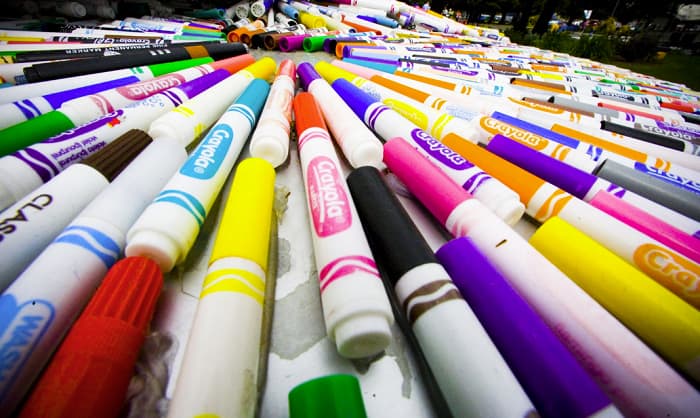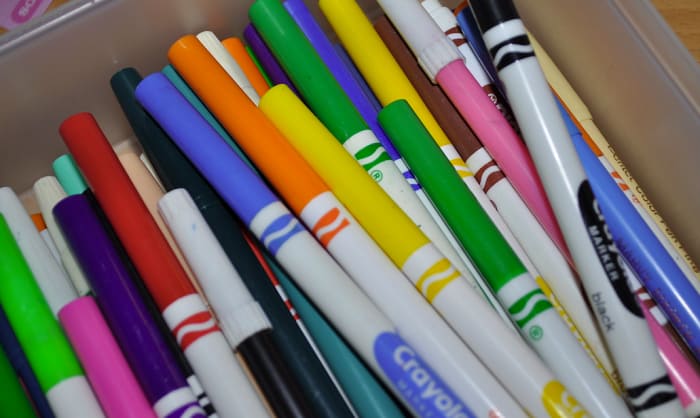Are Crayola markers vegan?
Sorry to break it, but it’s a NO! They are not vegan-friendly.
In 2018, Crayola confirmed that some of its products do contain animal by-products. However, they iterated that the company does not do animal testing.
On their site, Crayola made it clear that all Crayola markers, Crayola crayons, and other art supplies are certified safe. This declaration is backed by ACMI(Art and Creative Materials Institute).
After all, if it’s vegan, it should be all over its marketing and packaging materials from the start.
Table of Contents
Important Question: Are Crayola Markers Vegan?
According to That Vegan Teacher’s Crayola products inpression, the tricky part is inside that cotton filament and Crayola marker dyes.
We are all curious about what substances are the coloring agents of Crayola markers made out of and whether there are animal derived sources in them.
1. Hidden ingredient list
Crayola marker ingredients are generally declared to be made from water and dyes, with no other information stated. The actual list of ingredients that goes out of that porous plastic nib is kept hidden for proprietary reasons.
2. Markers in the past
In the past, ink solutions and art supplies were originally made from various raw materials, colors, and pigments extracted from plant or animal sources.
Black pigments are made with ivories and bone char. Stearic acid from processed beef fat, natural paint brushes from animal hair, and many art supplies are mostly considered animal products.
Through time, these natural raw materials are becoming more limited and restricted. With that, art supplies manufacturers continue to innovate and search for other alternatives.
3. Marker production today
Today, manufacturing is no longer limited to natural resources. More options are available, and inks can now be made using synthetic derivatives while the bases can be as simple as water, alcohol, and other complex solvents like Alkylene Carbonates.
Other additives and emulsifiers are made with long saturated fatty acids, for example, vegetable oils and other plant sources. Somehow, trying to adapt to increasing customers with a vegan lifestyle.
In general, this helps manufacturers like Crayola develop new products such as markers and crayons with bright neon colors, Erasable Metallic Markers, and the new Crayola markers washable, Ultra-Clean.
4. Crayola’s production
However, it looks like Crayola doesn’t have plans on ditching stearic acid, animal fats, and other raw materials with animal by-products.
I’m not vegan but I’m happy to share that other companies have started shifting to plant-based and vegan friendly alternatives. Some small manufacturers experimented and successfully made crayon vegan.
5. Animal cruelty-free markers
Other big art brands like Copic and Chartpak have already developed vegan markers that are certified animal cruelty-free. Chameleon and Pilot have their own versions of vegan pens and vegan markers.
6. Crayola ink is not edible
Although Crayola products are not vegan, Crayola markers are safe to be used by children. But, do note that Crayola markers non-toxic claims do not make Crayola markers edible.
They can still cause irritations or allergies at certain levels, and not all skins have the same tolerance. Crayola markers and crayons, regardless of their brand, vegan or not, should be used appropriately.
Most importantly, using markers, crayons, and other coloring products for toddlers and babies should still be under adult supervision.
What Are Crayola Markers Made From?
Crayola marker is manufactured using 6 basic components.
1. Plastic barrel
Plastic injection is used to create the plastic barrel. They have various variations, but they all come from the same mold and are afterward identifiable with Crayola prints based on their colors.
2. Plastic nib
The tip is used to aid and control ink flow. This porous plastic nib is usually made with absorbent material or molded powder.
3. Filament
It serves as the ink reservoir. Filaments are made with polyester or cotton filament that can hold and release the ink through capillary action.
4. Plastic Cap
This cap covers the tip to prevent it from drying. Like the barrel, the plastic cap is similarly made by injection molding using a different mold.
5. Plug
It seals the bottom part of the marker. It’s also made by plastic injection.
6. Coloring solution
The solution contains ink and other active coloring ingredients or additives that could contain raw materials made of animals byproduct.
Most of the components are made from plastic, a petroleum derivative.
Frequently Asked Questions
Are Crayola markers toxic?
No, their markers and crayons under the Crayola brand are manufactured and designed to be non-toxic. This claim is certified by the Art & Creative Materials Institute, Inc.
In Section 11 of their SDS(Safety Data Sheet), according to its toxicological information, none of the product’s components or ingredients are found in the ACGIH, IARC, or DFG.
Section 15, the regulatory section, this product is said to be deregulated, and none of its components are listed under California Proposition 65.
And is said to conform to ASTM D-4236 standard practice for labeling art materials for acute and chronic adverse health hazards.
What are the best brands of vegan crayons?
Here are some of the crayon boxes that are absolutely vegan. No paraffin wax and other animal ingredients.
- Azafran Organic Crayon: Made with food-grade coloring materials, soya wax, and soya butter that are all organic.
Most users find it sturdy and do not easily break, though these crayons can leave stains on the hands. However, stains are easily washable.
- Natural Veggie Crayons: Uses organic ingredients such as edible soy wax, powdered vegetables, and fruits.
Users love its chunky size but colors are not as sharp as the usual crayons. It also comes with a fruity smell that others find misleading.
What are Crayons made of?
Crayola crayons and other crayons are basically colored wax made of color pigments and different waxes such as paraffin wax, carnauba wax, and beeswax.
The Crayola crayons manufacturing process also requires to use animal fat such as stearic acid as toner that gives it a distinctive Crayola smell and milk casein as binder.
Related: what are Crayola markers made of?
Are Expo markers vegan?
Expo is not yet clear on its vegan status and does not declare itself as a completely vegan manufacturer. Their dry erase and permanent markers do not have listed ingredients made of animals and its byproduct.
However, raw materials are not guaranteed to be vegan friendly. In addition, they also do not do test on animals and have a recycling program for their plastic waste.
Conclusion
The answer to the question, are Crayola markers vegan is clear. Their crayons and markers are not vegan but they are still safe to use for children.
Vegans can opt for:
- Other vegan alternatives such as Copic markers, Chartpak vegan markers, or Expo markers.
- Go for vegan crayons like Azafran Crayons or Veggie Baby Crayons as alternatives to Crayola crayons. Stay away from crayons with stearic acid.
- Check vegan products and art supplies list from Double Check Vegan.
Make it a habit to review the ingredients list or ask customer service if it’s not stated in the packaging before buying.
Read next: Crayola marker lifespans – here is the answer

Art has always been a part of my life; it influences my upbringing and later my career choice. For me, it is always a part of my parenting technique. So for whichever purpose that you come to art, you can start here with us.



